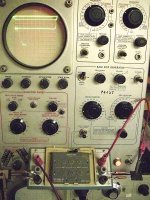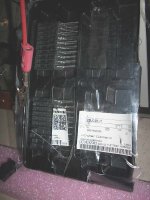More capacitance more capacitance more capacitance. Papa uses about 100kuF more. Power supply is super important and more capacitance means more everything, not just bass. Overdo it. Dont regret it. How about those Panasonic TSHA? 10,000uf at 35V and you could buy 10 for about $50. They are really good caps.
Uriah
Uriah
I have rifa peh169 caps 63v 10000uf x10 pieces.I will parallel them.They are big caps but very high quality.What do you think about it?Are they much more for F5 amp?
There is the inrush current to take into consideration. This might mean an inrush current limiter circuit to stop blowing fuses.
Rifa peh 169 is better than tsha i think
I think you missed my point, plus it was pointed at the guy using 40kuF.
TOSHIBA Matching Update
Hey F5'ers...
A quick update.
I did further measurements regarding the actual spread of the bias points for the batch of Js & Ks that I have on hand. It appears that the biggest spread is on the order of <200mvdc gate bias for the same current matching point. This is good, since the curve tracer displays minutia very well, and it looked like the spread was far far more than that. It's actually rather small in practice.
What this means is that for the double Mosfet (2 per rail) boards pairs from ends of the spread will not really be far apart at all and should work fine. Pairs for the standard one Mosfet per rail F5 will be easy.
I'll be posting to Swap early in the week, I need to get some ducks in a row first...
_-_-bear
Hey F5'ers...
A quick update.
I did further measurements regarding the actual spread of the bias points for the batch of Js & Ks that I have on hand. It appears that the biggest spread is on the order of <200mvdc gate bias for the same current matching point. This is good, since the curve tracer displays minutia very well, and it looked like the spread was far far more than that. It's actually rather small in practice.
What this means is that for the double Mosfet (2 per rail) boards pairs from ends of the spread will not really be far apart at all and should work fine. Pairs for the standard one Mosfet per rail F5 will be easy.
I'll be posting to Swap early in the week, I need to get some ducks in a row first...
_-_-bear
Only a few Tosh's for sale in Swap area
I only have a few sets for sale in the swap area...
First come first served.
If the demand is huge, I can go and buy a really large batch...
Post there, not here.
there is here:
TOSHIBA MOSFETS
Awayne, out of this batch there was no possibility to find the number that you wanted. Zilch. I would need a batch of 200-400 per type to find the number you wanted...
So, post up if you want them, even if I run out (and I will, there aren't that many to begin with...) otherwise I won't want to go out and buy several hundreds of each type myself.

_-_-bear
I only have a few sets for sale in the swap area...
First come first served.
If the demand is huge, I can go and buy a really large batch...
Post there, not here.
there is here:
TOSHIBA MOSFETS
Awayne, out of this batch there was no possibility to find the number that you wanted. Zilch. I would need a batch of 200-400 per type to find the number you wanted...
So, post up if you want them, even if I run out (and I will, there aren't that many to begin with...) otherwise I won't want to go out and buy several hundreds of each type myself.
_-_-bear
Attachments
Last edited:
Balanced or Bridged
I'm interested in this myself. What are the pros and cons?
Thanks,
Steve
Is there a disadvantage of balanced or bridged?
I'm interested in this myself. What are the pros and cons?
Thanks,
Steve
Good for you, i certainly did not.
Hey Jacco,
When I said I got it now, I meant Andrew's post. I was in a hurry and did not have time to elaborate.
For some reason, initially, only the top portion of his post came through. I uderstood what he said. But, I did not understand how the current draw is different between the balanced and bridged versions (for the same impedance loads).
Thanks,
Steve
Are they matched at room temperature or at steady state on heat sink ?
Curve tracer matched Quad Comps are a must for those serious builders for Xed F5.
Can your curve tracer output data in digital format for post processing ?
Patrick
Room temp, which is cool.
The device does not heat much during test, unlike a static bias test jig.
I could let them cook for a while (actually I did... on a few to look at the change) but my experience with the Hitachi's is that there isn't a whole lot of difference in the spread when tested warm or cool. The pix from Luvdunhil's posts when he was selling them shows the same thing... fwiw. No worries, mate! ;D
this is an older Tek 575, no digital anything.
Yes, for the X5 or the CViller boards having the devices on each rail very close is important...
_-_-bear
Last edited:
I was told that theres no matching of NPN to PNP
Matched pairs are 2x matched NPN, and 2x matched PNP
So, fore F5 with single pairs theres no need fore matching

Correct.
I only have a few sets for sale in the swap area...
First come first served.
If the demand is huge, I can go and buy a really large batch...
Post there, not here.
there is here:
TOSHIBA MOSFETS
Awayne, out of this batch there was no possibility to find the number that you wanted. Zilch. I would need a batch of 200-400 per type to find the number you wanted...
So, post up if you want them, even if I run out (and I will, there aren't that many to begin with...) otherwise I won't want to go out and buy several hundreds of each type myself.
_-_-bear
Yes i need as we previously discussed , so go ahead and let me know ....
So, for F5 with single pairs there's no need for matching
This is true. However, if you know what you are looking
for, there's nothing that beats socketing parts and swapping
them in and out until you get what you want.
Currently I do this with J2's, as I have not found a matching
pattern that easily predicts performance. Of course this also
has to be done at temperature.
I was told that theres no matching of NPN to PNP
Matched pairs are 2x matched NPN, and 2x matched PNP
So, fore F5 with single pairs theres no need fore matching

I wouldn't say that exactly.
I'd bet with a big lot of P & Nch maybe 1000pcs of each there would be a few dozen or so that would end up being dead on or nearly so in the center of the "sweet zone" - that being the overlap of the bias points...
Not having had enough in my hands of the Tosh's I can't say for sure how they usually end up. The old Hitachi metal can J49 & J56 (iirc) and their complements were overlapping to a small degree... I was able to find some that were dead bang on, but they did not have (allegedly) matching transfer curves as do the Tosh's...
_-_-bear
Ok, I just wondered about your batch #3#
Just one single set of matched pairs
One channel bought as a stereo set
Matching makes the 2 pairs cost more than common commercial unmatched devices
Maybe a mistake, but it seems pointless
In fore a refund ?
If you had split your matching up in ALL martched pairs, instead of matched quads, you might have gotten more and better matches, and cheaper
Just one single set of matched pairs
One channel bought as a stereo set
Matching makes the 2 pairs cost more than common commercial unmatched devices
Maybe a mistake, but it seems pointless
In fore a refund ?
If you had split your matching up in ALL martched pairs, instead of matched quads, you might have gotten more and better matches, and cheaper
It doesn't work that way tinitus...
The way I did it was to characterize all the devices without regard to where it was going to go. Then I looked at them. My interest was to get good matches for my own Cviller boards, even if I build them up as std F5, at least to have enough devices.
So after looking at the groups it became immediately obvious that there were a number of very lucky "quads" in both N & P. Knowing that some people want to make Cviller boards I offered them up as N + P quads.
The advantage of quads is that the bias points on both channels of the F5cv will bias at exactly the same point. Since NP has stated that the bias point effects the harmonics and the way the amp sounds, this way one is assured of having two channels that are indeed so similar as to be deemed identical in this regard.
If you build without each gender of device being the same Vgs between two channels, maybe not such a big deal, maybe is... but in the F5cv build it becomes important because the devices are running in parallel.
All in all it is merely closer to some degree of "perfection".
Not necessary at all to make the amp run, but also not a bad idea if you are trying to optimize.
And, yes, matching costs more than unmatched common commercial devices... there is time and effort involved, plus the outlay of cash to acquire a sufficient number of devices to arrive at a match...
I guess it all depends on what you think is important or what you want...
No one is obligated to buy anything?
The way I did it was to characterize all the devices without regard to where it was going to go. Then I looked at them. My interest was to get good matches for my own Cviller boards, even if I build them up as std F5, at least to have enough devices.
So after looking at the groups it became immediately obvious that there were a number of very lucky "quads" in both N & P. Knowing that some people want to make Cviller boards I offered them up as N + P quads.
The advantage of quads is that the bias points on both channels of the F5cv will bias at exactly the same point. Since NP has stated that the bias point effects the harmonics and the way the amp sounds, this way one is assured of having two channels that are indeed so similar as to be deemed identical in this regard.
If you build without each gender of device being the same Vgs between two channels, maybe not such a big deal, maybe is... but in the F5cv build it becomes important because the devices are running in parallel.
All in all it is merely closer to some degree of "perfection".
Not necessary at all to make the amp run, but also not a bad idea if you are trying to optimize.
And, yes, matching costs more than unmatched common commercial devices... there is time and effort involved, plus the outlay of cash to acquire a sufficient number of devices to arrive at a match...
I guess it all depends on what you think is important or what you want...
No one is obligated to buy anything?
- Home
- Amplifiers
- Pass Labs
- F5 power amplifier

